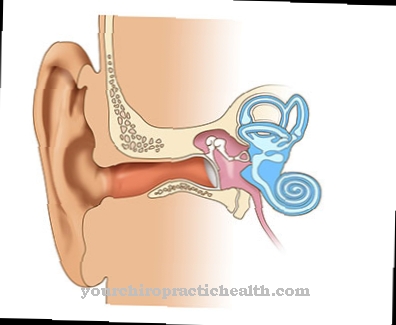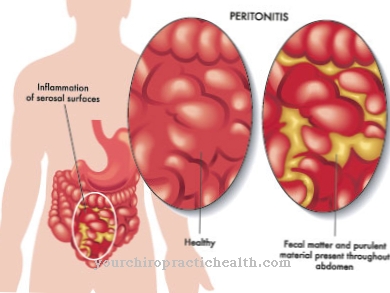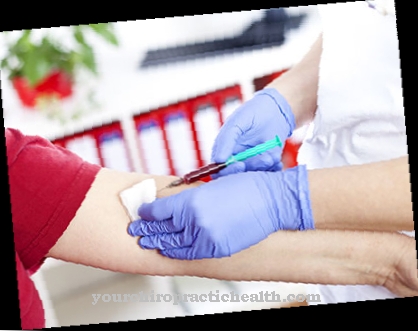Loiasis is a parasitic infectious disease caused by specific roundworms den Loa loa-Filaria, and manifests itself primarily through inflammatory, allergy-related swelling reactions. An estimated 3 to 30 percent of the population in the areas of distribution (West and Central Africa) are infected with Loa loa worms.
What is loa loa?
.jpg)
© Kateryna_Kon - stock.adobe.com
As Loiasis becomes an infection with the nematode (roundworm) Loa loa referred to, which is transmitted by diurnal brakes of the genus Chrysops and is found primarily in the tropical rainforest of West and Central Africa (Congo Basin).
Around two to twelve months after being infected with the loa loa, the parasite circulates in the subcutaneous tissue and connective tissue and occasionally in the subconjunctival tissue (eye connective tissue).
Allergic reactions to the loa loa worm lead to sudden, itchy swellings of the skin (so-called calabar bumps), especially on the face and legs, which persist for several days and can recur (recur) at irregular intervals. If the larynx is attacked by the loa loa parasites, life-threatening glottic edema (acute swelling of the larynx) can manifest itself.
causes
Loa loa is is a parasitic roundworm (filaria) that is transmitted by infected diurnal horseflies of the genus Chrysops.The microfilariae (larvae of the Loa loa worm) transmitted by the horsefly mature within the incubation period (2-9 months) in the infected human body into sexually mature, adult filariae that live in the subcutaneous tissue and connective tissue of the skin, mucous membranes and possibly eyes and within these structures can migrate (so-called "wandering filaments").
The adult (fully grown) filariae also produce a large number of infectious microfilariae in the connective tissue, which during the day enter the bloodstream via the lymphatic system and circulate there. Due to allergies, the spread of adult filariae and microfilariae cause the inflammatory reactions and swellings characteristic of loiasis.
If an infected person at this stage of the disease is bitten by a diurnal horsefly, it becomes infected and can transmit the infectious Loa loa microfilariae to other people or great apes. A direct transmission of the Loa loa worm from person to person can, however, be ruled out.
Symptoms, ailments & signs
Loa Loa or Loiasis is a worm infection that occurs in West Africa and mainly causes severe itchy skin swelling. The swellings are soft and can produce bumps up to ten centimeters in size. Usually, the bumps disappear after two to three days, but reappear in another place.
Usually only one arm or one foot is affected. The swellings represent an allergic reaction of the body to the roundworm. The migration of the roundworms also causes the swellings or bumps (Cameroon bumps or Calabar swellings) to migrate over the body. The disease is usually harmless.
Often, however, there is also a chronic course of more than ten years because the nematode is very long-lived. During this time, however, other organs such as the heart or kidneys can also be affected. Heart valve defects, kidney insufficiency or even meningitis may occur as late effects.
In rare cases, the creeping worm is also seen. This is especially true when it wanders through the eye. Because of this property, Loa Loa is also known as an eye worm. Although the disease is very protracted, it usually heals well after the worm dies. The worm can be surgically removed or killed using diethylcarbamazine.
Diagnosis & course
An infection with Loa loa-Parasites can usually be diagnosed based on the characteristic symptoms. The diagnosis of loiasis is confirmed by evidence of loa-loa microfilariae in the blood.
The blood sample should be taken during the day to prove that the microfilariae have adapted to the diurnal brake as an intermediate host and accordingly only circulate in the bloodstream at this time.
In addition, an immunofluorescence test can be used to detect the infection antibodies and diethylcarbamazine (DEC), which triggers itching after a single dose and provides indirect evidence of the microfilariae.
In the majority of cases, an infection with Loa loa is easily treatable and has a good prognosis. In rare cases, long-term loiasis can lead to late complications such as endocarditis, meningoencephalitis or kidney damage.
Complications
Loa loa comes with various ailments and complications that can occur all over the patient's body. In most cases, this leads to an allergic reaction in the body, so that those affected suffer from reddened skin or from itching on the skin. Scratching usually only increases the itchiness.
Especially in the face, the itching and redness can be very uncomfortable for those affected and lead to a reduced self-esteem. It is not uncommon for the eyes to water and cause eye pain. Complications from loa loa usually only occur if treatment is not given or if treatment is initiated very late.
The patients can also suffer damage to the kidneys, so that in the worst case scenario, kidney failure occurs. The patient then has to rely on dialysis or a kidney transplant. Treatment of loa loa is carried out with the help of drugs. There are no complications. It is not uncommon for those affected to appear tired and exhausted and can no longer actively participate in life. In most cases, however, the disease progresses positively.
When should you go to the doctor?
Swelling of the skin and itching are signs of an existing disease. If the symptoms persist for several days or weeks, a doctor should be consulted. If the itching leads to the development of open wounds, the affected person needs sterile wound care. If this cannot be sufficiently guaranteed, a doctor should be consulted. If pus forms or the affected parts of the body hurt, a doctor's visit is necessary. The person concerned is threatened with blood poisoning, which without medical care can lead to a life threatening. If you notice the formation of bumps, which recede automatically after a few days and then reappear in another part of the body, the observations should be discussed with a doctor.
In most cases, the diseased areas are on the patient's arms or feet. Without treatment, kidney function will be impaired in the long term. Therefore, a doctor should be consulted in the event of kidney dysfunction, difficulty urinating, or changes in urine. If there are abnormalities in the heart's activity, changes in blood pressure or heart rhythm, the person concerned needs a doctor. In the event of a general feeling of illness, malaise, internal weakness or a decrease in normal performance, a doctor's visit is also necessary.
Treatment & Therapy
A Loiasis is generally treated with medication with diethylcarbamazine, an anthelmintic or worming agent, which kills the loa loa microfilariae and sometimes the adult filariae by interfering with the pathogen's metabolism.
Initially, a lower dose that should be gradually increased is recommended, as the very high number of dying Loa loa parasites releases toxic substances that can cause pronounced allergic reactions such as rashes, asthmatic attacks, fever and fatigue in the human organism (so-called mazzotti -Reaction). Antihistamines or corticosteroids should be taken at the same time to inhibit or weaken such allergic reactions as well as to reduce itching and inflammatory reactions.
In some cases, other anthelmintics such as ivermectin or albendazole are used prior to diethylcarbamazine therapy. Diethylcarbamazine is contraindicated if you are pregnant or if other parasitic infectious diseases such as Dirofilaria immitis or onchocerciasis are present because of the allergic reactions triggered by the toxins released.
The proteinuria (excretion of proteins in the urine) that is associated with diethylcarbamazine therapy in some cases is usually temporary in loiasis. If Loa loa parasites are visible in the conjunctiva of the eye, they can be surgically removed under local anesthesia (anesthetic).
Outlook & forecast
The prognosis of the loa loa depends on the time of diagnosis and treatment, but also on the basic course of the disease. In many cases, the pathogen has already been in the organism for a few months before clearer health problems appear. For this reason, the worm can spread until it is detected and already cause internal damage.
If the disease is discovered at an early stage, drug treatment can be initiated. Normally, this leads to an alleviation of the symptoms and a subsequent freedom from symptoms within a short period of time. With an unfavorable course of the disease, the first internal organ damage has already developed.
In severe cases, kidney failure can occur. This represents a potential danger to human life. Often a donor organ is needed so that there is a prospect of recovery. The transplant is complex and has numerous side effects. The donor organ is not always well received by the organism. There may be reactions of rejection and thus a further deterioration in the general state of health. The prognosis is also worsened if the disease becomes chronic. Despite the administration of medication, there is a possibility that the pathogen will not be completely killed. Therefore, it is not uncommon for therapy to be carried out for up to ten years.
prevention
On the other hand Loa loa So far no vaccine exists, the preventive measures are limited to exposure prophylaxis. This includes wearing light-colored clothing that covers the skin and using repellents (sprays, creams, lotions to repel insects) and mosquito nets to protect against bites from horseflies infected with loiasis.
You can do that yourself
If a loasis is suspected, a doctor should be consulted first. A doctor must clarify the disease and, if necessary, initiate treatment. Some self-help measures and various resources from the household and nature support the healing process.
Drug therapy can be supported by an active and healthy lifestyle. While rest and bed rest still apply in the first days after the illness, light sport can be practiced after the acute phase. Exercise in the fresh air strengthens the immune system and relieves symptoms such as fatigue and asthma. If serious complications arise, the doctor must be informed. Loa Loa can be treated well, but it must be closely monitored by a doctor. Otherwise secondary diseases can develop.
The drug treatment can also be supported by a complaints diary. In it, the sick should record any side effects and interactions as well as the effects of the preparation on rashes and other typical symptoms. With the help of these notes, the doctor can optimally adjust the medication and ensure rapid healing. At the same time, new infections must be avoided by taking the necessary precautionary measures.

.jpg)




.jpg)




















